- From the Baishan fir (five left in the world) to the Sumatran rhino (around 250), a new report highlights the world’s top 100 most endangered species, according to the the International Union for Conservation of Nature (IUCN) and the Zoological Society of London (ZSL).
- The list spans the taxonomic gamut, from fungi (Cryptomyces maximus) to amphibians (the Table Mountain ghost frog) to flowers (the Cayman Islands ghost orchid) and much more (see full list at the end of the article).

Only described in 2010, its unknown how many Durrell’s vontsiras (Salanoia durrelli) survive. Photo by: Ian Vernon and Tim Hounsome with the Durrell Wildlife Conservation Trust.
From the Baishan fir (five left in the world) to the Sumatran rhino (around 250), a new report highlights the world’s top 100 most endangered species, according to the the International Union for Conservation of Nature (IUCN) and the Zoological Society of London (ZSL). The list spans the taxonomic gamut, from fungi (Cryptomyces maximus) to amphibians (the Table Mountain ghost frog) to flowers (the Cayman Islands ghost orchid) and much more (see full list at the end of the article).
“The species featured here represent the 100 most critically endangered species in the world,” announces the report. “If we don’t rapidly increase the amount of conservation attention that they receive they may soon be lost forever.”
Listed in alphabetical order, the report represents the best knowledge available on endangered species. While scientists to date have described nearly 2 million species on Earth, most believe several million (and perhaps tens-of-millions) remain undiscovered. In addition, scientists generally have far more data on the populations and threats facing vertebrate species, such as mammals and amphibians, than they do of insects, plants, and fungi. Still, these 100 near-extinct species highlights the increasing global biodiversity crisis, which could result in a mass extinction with untold consequences for the world’s ecosystems.
“All the species listed are unique and irreplaceable,” co-author Ellen Butcher with ZSL said in a statement. “If they vanish, no amount of money can bring them back. However, if we take immediate action we can give them a fighting chance for survival. But this requires society to support the moral and ethical position that all species have an inherent right to exist.”
While a few of these species have seen targeted conservation efforts, such as the Sumatran rhino and the saola, many lack any conservation efforts.
“The donor community and conservation movement are leaning increasingly towards a ‘what can nature do for us’ approach, where species and wild habitats are valued and prioritized according to the services they provide for people. This has made it increasingly difficult for conservationists to protect the most threatened species on the planet,” says ZSL’s Director of Conservation, Jonathan Baillie, and co-author of the report.
The report also highlights that targeted conservation efforts in the past has had numerous successes in keeping species from vanishing for good, such as Prezwalski’s horse, the humpback whale, and the black robin. Still the general trend outlined by scientists is a global decline in biodiversity.
“Society is at a point in history where a decision needs to be made,” Baillie writes in the report. “Do these species have the right to exist?”

Less than 250 great Indian bustards (Ardeotis nigriceps) survive. Photo by: Rahul Sachdev.
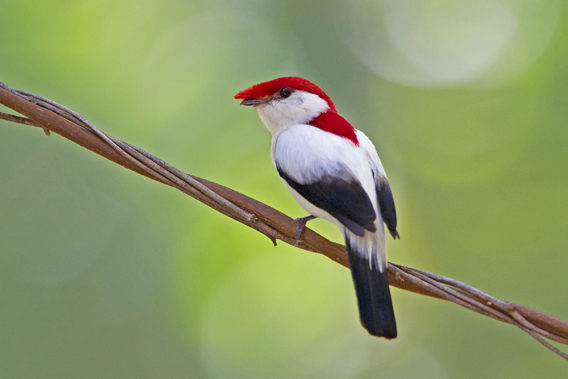
Less than 800 Araripe manakins (Antilophia bokermanni) survive. Photo by: Ciro Albano.
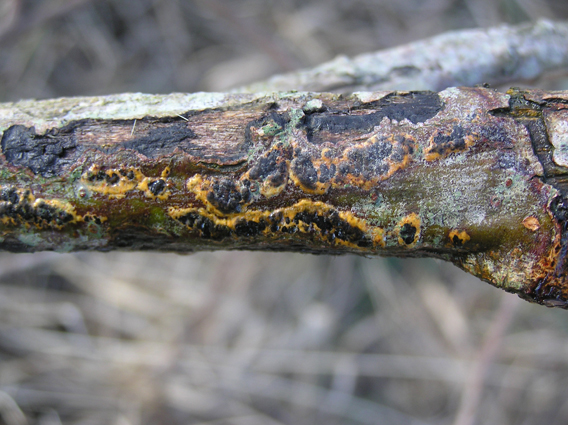
This fungus, Cryptomyces maximus, is facing extinction. Photo by: David Harries.
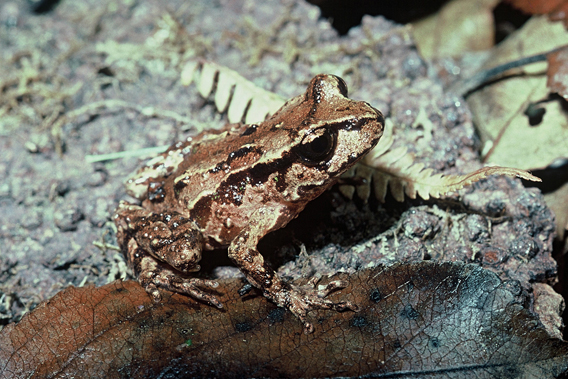
Archey’s frog (Leiopelma archeyii), native to New Zealand, is in big trouble. Photo by: New Zealand Department of Conservation.

Amsterdam Island albatross (Diomedea-amsterdamensis), is down to only 100 birds. Albatrosses are among the world’s most endangered birds. Photo by: Eric van der Vlist.

About 250 Sumatran rhinos (Diceros sumatrensis) survive in a few different populations. Photo by: Save the Rhino International.
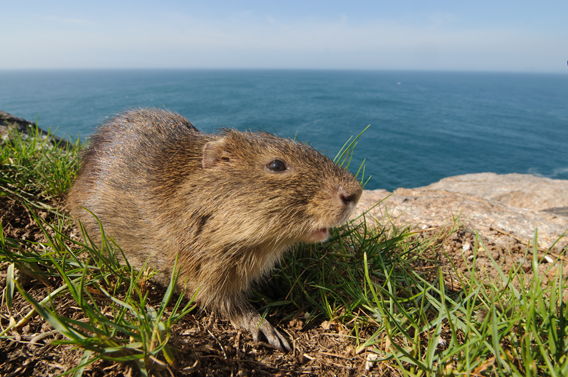
Santa Catarina’s guinea pig (Cavia intermedia) is down to about 40-60 animals. Photo by: Luciano Candisani.
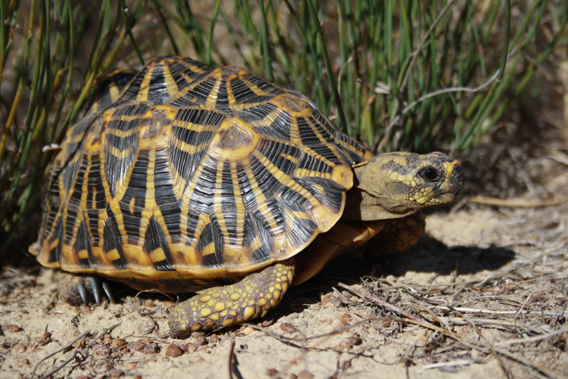
The geometric tortoise (Psammobates geometricus) has lost almost all of its habitat in South Africa. Photo by: Erik Baard.

The Okinawa spiny rat (Tokudaia muenninki) is only found on the Japanese Island of Okinawa. Already, Japan has lost several of its endemic mammals. Photo by: Norihiro Kawauchi.
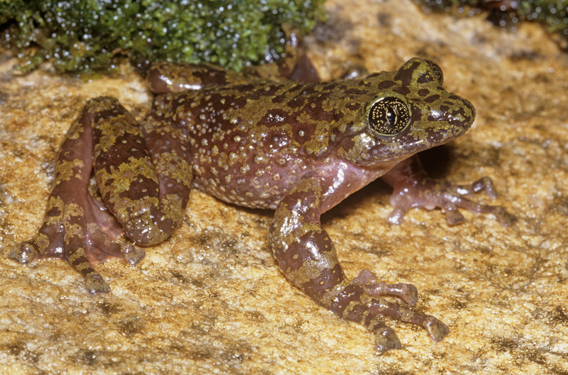
The Table Mountain ghost frog (Heleophryne rosei) is only found on a single mountain in South Africa. Photo by: Atherton de Villiers.
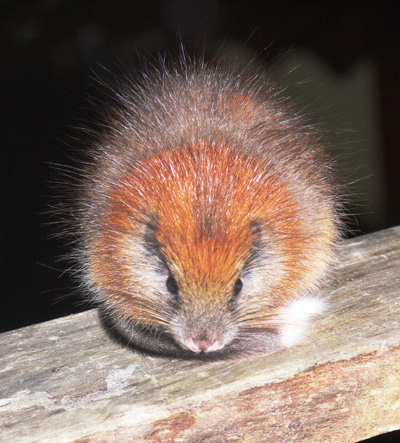
The red-crested tree rat (Santamartamys rufodorsalis) was discovered last year in Colombia after missing for over a century. Photo by: Lizzie Noble/Pro Aves.
| Scientific Name | Common Name | Category | Population | Threats to Survival Action Required |
| Abies beshanzuensis | Baishan Fir | Conifer | 5 mature individuals | Agricultural expansion and fireEx-situ conservation and re-introduction, and establishment of a protected area |
| Actinote zikani | butterfly | Unknown, one population remaining | Habitat degradation due to pressure from human populationsProtection of habitat and Mikania obsoleta (host plant) | |
| Aipysurus foliosquama | Leaf scaled sea-snake | sea-snake | Unknown, two subpopulations remain | Unknown – likely degradation of coral reef habitatEvaluate reasons for population decline and formulate appropriate management plans |
| Amanipodagrion gilliesi | Amani Flatwing | butterfly | <500 individuals est. | Habitat degradation due to increasing population pressure and water pollutionHabitat protection |
| Antilophia bokermanni | Araripe Manakin | bird | 779 individuals (est 2010) | abitat destruction due to expansion of agriculture and recreational facilities and water diversionFormal protection of remaining habitat and protection of springs and streams |
| Antisolabis seychellensis | Seychelles earwig | earwig | Unknown (declining) | Invasive species and climate changeHabitat management to prevent further invasion by introduced plants |
| Aphanius transgrediens | freshwater fish | Unknown (declining) | Competition and predation by Gambusia and road construction Raise awareness in national conservation groups and governments, monitor and conserve current springs, develop action plan for lost springs and maintain captive populations | |
| Aproteles bulmerae | Bulmer’s Fruit Bat | bat | 150 individuals (est) | Hunting and cave disturbanceProtection of Luplupwintern cave and enforced prohibition of hunting |
| Ardea insignis | White bellied heron | bird | 70-400 individuals | Habitat destruction and degradation due to hydropower development Develop captive rearing and release program, eliminate adverse uses of riverine habitat, and mitigate effects of hydroelectric development |
| Ardeotis nigriceps | Great Indian Bustard | bird | 50 -249 mature individuals | Habitat loss and modification due to agricultural developmentEstablishment of protected areas and community reserves, and realignment of Indira Ghandi Nahar Canal Project |
| Astrochelys yniphora | Ploughshare tortoise / angonoka | tortoise | 440-770 | Illegal collection for international pet tradeEnforcement of legal protection and protected area management |
| Atelopus balios | Rio pescado stubfoot toad | toad | Unknown (declining) | Chytridiomycosis and habitat destruction due to logging and agricultural expansionProtection of last remaining habitat |
| Aythya innotata | Madagascar Pochard | bird | approximately 20 mature individuals | Habitat degradation due to slash-and-burn agriculture, hunting, and fishing / introduced fishFormal protection of current breeding site, habitat restoration, and development of release programme for captive-bred individuals |
| Azurina eupalama | Galapagos damsel fish | pelagic fish | Unknown (declining) | Climate Change – oceanographic changes associated with the 1982 / 1983 El Nino are presumed to be responsible for the apparent disappearance of this species from the Galapagos Surveys to identify if the species still exists in Los Lobos Islands |
| Bahaba taipingensis | Giant yellow croaker | pelagic fish | Unknown (declining) | Over-fishing, primarily due to value of swim-bladder for traditional medicine – cost per kilogram exceeded that of gold in 2001Establishment of appropriate protection in Hong Kong and enforcement of legal protection in China |
| Batagur baska | Common Batagur/ Four-toed terrapin | turtle | Unknown (declining) | Illegal export and trade from Indonesia to China Enforcement of CITES Appendix I restrictions and control of illegal trade |
| Bazzania bhutanica | liverwort | Unknown (declining) | Habitat degradation and destruction due to forest clearance, overgrazing and development Protection of area to prevent future development damaging remaining habitat | |
| Beatragus hunteri | Hirola | antelope | < 1000 individuals | Habitat loss and degradation, competition with livestock, poachingEstablishment of protected areas and community conservancies, increase in level of management and protection of wild population |
| Bombus franklini | Franklin’s Bumble Bee | bee | Unknown (declining) | Disease from commercially bred bumblebees and habitat destruction and degradationProtection of habitat containing nectar and pollen sources |
| Brachyteles hypoxanthus | Northern muriqui | primate | < 1,000 individuals | Habitat loss and fragmentation due to large-scale deforestation and selective loggingHabitat protection and commitment of resources to support the implementation of the national action plan |
| Bradypus pygmaeus | Pygmy sloth | sloth | <500 individuals | Habitat loss due to illegal logging of mangrove forests for firewood and construction and hunting of the slothsEnforcement of protection of the Isla Escudo de Veraguas nature sanctuary and raising awareness |
| Callitriche pulchra | freshwater plant | Unknown (declining) | Exploitation of the species’ habitat by stock, and modification of the pool by local peopleProvide alternative water sources for stock, involve local people in the protection of the pool and document remaining water bodies on Gavdos | |
| Calumma tarzan | Tarzan’s chameleon | chameleon | Unknown | Habitat destruction for agricultureSupport for nascent community conservation initiatives and protection of habitat |
| Cavia intermedia | Santa Catarina’s guinea pig | guinea pig | 40-60 individuals | Habitat disturbance and possible hunting; small population effectsProtected area enforcement and regulation of access to the island |
| Cercopithecus roloway | Roloway Guenon | primate | Unknown | hunting for consumption as bushmeat, and habitat lossProtection of habitat from logging and conversion to agricultural land |
| Coleura seychellensis | Seychelles sheath-tailed bat | bat | <100 mature individuals (est 2008) | Habitat degradation and predation by invasive speciesRemoval of invasive vegetation and control of introduced predators, coupled with legal protection of habitat and roosting sites |
| Cryptomyces maximus | fungus | Unknown (declining) | Limited availability of habitatcontinue protection of current populations and habitat regeneration projects | |
| Cryptotis nelsoni | Nelson’s small-eared shrew | shrew | Unknown (declining) | habitat loss due to logging cattle grazing, fire and agriculture |
| Cyclura collei | Jamaican iguana | iguana | Unknown (declining) | Predation by introduced species and habitat destructionTranslocation to predator-free islands and control of deforestation development of legislation that will facilitate the protection of the Ironwood Forests |
| Dendrophylax fawcettii | Cayman islands ghost orchid | orchid | Unknown (declining) | Habitat destruction due to infrastructure developmentDevelopment of legislation that will facilitate the protection of the Ironwood Forests |
| Dicerorhinus sumatrensis | Sumatran rhino | rhino | <250 individuals | Hunting for horn -used in traditional medicineExpansion and reinforcement of anti-poaching programmes and continuation of captive breeding efforts |
| Diomedea amsterdamensis | Amsterdam Island albatross | bird | 100 mature individuals | disease and incidental capture in long-line fishing operationsPrevention of the spread of disease and promotion of best-practice measures in all fisheries within the species range |
| Diospyros katendei | tree | 20 individuals, one population | High pressure from communities for agricultural activity, illegal tree felling, habitat degradation due to alluvial gold digging and small populationEnforcement of legal protection of area, field surveys for further search and ex situ conservation in arboreta / botanic gardens | |
| Dipterocarpus lamellatus | dipterocarp (tree) | 12 individuals | Habitat loss and degradation due to logging of lowland forest and creation of industrial plantationsRestoration of Sianggau Forest Reserve and re-introduction of species to previous range | |
| Discoglossus nigriventer | Hula painted frog | frog | Unknown (recent rediscovery in 2011) | Predation by birds and range restriction due to habitat destructionrestoration of habitat |
| Discorea strydomiana | Wild Yam | yam | 200 individuals | Collection for medicinal useDevelop strategy for sustainable use and establish ex situ populations |
| Dombeya mauritiana | flowering plant | Unknown (declining) | Habitat degradation and destruction due to encroachment by alien invasive plant species and cannabis cultivationControl of invasive plant species, habitat protection and re-introduction of propagated individuals | |
| Elaeocarpus bojeri | flowering plant | <10 individuals | Small population and degraded habitatUnknown – trees are currently being closely monitored to determine level of threat and how these should be addressed | |
| Eleutherodactylus glandulifer | La Hotte Glanded Frog | frog | Unknown (declining) | Habitat destruction due to charcoal production and slash-and-burn agricultureHabitat protection |
| Eleutherodactylus thorectes | Macaya Breast-spot frog | frog | Unknown | Habitat destruction due to charcoal production and slash-and-burn agriculture Protection of habitat |
| Eriosyce chilensis | Chilenito | cactus | <500 individuals | Collection of flowering individualsProtection of plants through construction of a fence and signage alerting people to threatened status |
| Erythrina schliebenii | coral tree | flowering tree | < 50 individuals | Limited habitat and small population size increasing vulnerability to stochastic eventsComplete establishment of Forest Reserves and continue propagation efforts, ex situ conservation |
| Euphorbia tanaensis | semi-deciduous tree | 4 mature individuals | Illegal logging and habitat degradation due to agricultural expansion and infrastructure development Enforcement of legal protection in the Witu Forest Reserve, which has diminished due to civil insecurity | |
| Eurynorhynchus pygmeus | Spoon-billed sandpiper | bird | < 100 breeding pairs | Trapping on wintering grounds and land reclamation.Maintenance of critical intertidal staging posts and reducing trapping on wintering grounds. |
| Ficus katendei | tree (ficus) | < 50 mature individuals | Agricultural activity, illegal tree felling and habitat degradation due to alluvial gold diggingex-situ conservation in arboreta / botanic gardens; enforcement of protection to contain encroachment and habitat degradation; community development programmes in areas adjacent to the reserve | |
| Geronticus eremita | Northern Bald Ibis | bird | 200-249 mature individuals | Habitat degradation and destruction, and huntingProtection of key breeding and roosting sites |
| Gigasiphon macrosiphon | flowering tree | 33 mature individuals | Timber extraction and habitat degradation due to agricultural encroachment and development, seed predation by wild pigsEnforcement of protection in reserves and establishment of management plan to mitigate effects of water loss from hydroelectricity developments | |
| Gocea ohridana | mollusc | Unknown (declining) | Habitat degradation due to increasing pollution levels, off-take of water and sedimentation eventsImplement transboundary agreements to improve habitat management | |
| Heleophryne rosei | Table Mountain ghost frog | frog | Unknown (declining) | Habitat degradation due to invasive plants and water abstractionProtection of habitat, continued implementation of management plans and integration of activities between sites |
| Hemicycla paeteliana | mollusc | Unknown (declining) | Habitat destruction due to overgrazing and trampling by goats and touristsConservation of habitat and control of goats, and limiting recreational access to area by tourists | |
| Heteromirafra sidamoensis | Liben Lark | bird | 90- 256 individuals | Habitat loss and degradation due to agricultural expansion, over-grazing and fire suppressionRestoration of grasslands, including establishing sustainable land management practices, clearing scrub and reinstating fire regime |
| Hibiscadelphus woodii | hibiscus | Unknown | Habitat degradation due to feral ungulates and invasive introduced plant speciesSurvey the extremely steep terrain for additional individuals. Control of invasive species in the remaining suitable habitat so that species can be reintroduced if more individuals are located | |
| Hucho perryi (Parahucho perryi) | Sakhalin taimen | salmonid | Unknown (declining) | Overfishing (sport fishing and commercial bycatch) and habitat loss from damming, agriculture and other land use practices.Expansion of conservation protection in rivers in Russia and Japan and enforcement of fishing regulations |
| Johora singaporensis | Singapore Freshwater Crab | crab | Unknown | Habitat degradation – reduction in water quality and quantityProtection of remaining habitat and establishment of ex-situ populations |
| Lathyrus belinensis | sweet-pea | <1,000 (2010 est) | Habitat destruction due to urbanisation, over-grazing, conifer planting and road widening Habitat protection, control of grazing, halt conifer planting and periodic sampling for ex situ seed conservation | |
| Leiopelma archeyi | Archey’s frog | frog | unknown but declining | Chytridiomycosis and predation by invasive speciesContinuation of current conservation efforts |
| Lithobates sevosus | Dusky gopher frog | frog | 60-100 individuals (est 2003) | Fungal disease and habitat limitation due to climate change and land-use changesProtection of habitat and management of population to prevent spread of disease |
| Lophura edwardsi | Edward’s pheasant | bird | Unknown | hunting and habitat lossEffective law enforcement, habitat restoration and development of a captive breeding programme |
| Magnolia wolfii | magnolia | Unknown (declining) | Isolation of species and low regeneration ratesProtection of remaining population and exploration of potential for ex-situ conservation | |
| Margaritifera marocana | mussel | <250 individuals (2010 est) | Habitat degradation and disturbance due to pollution and development Habitat protection to mitigate effects of construction of hydroelectricity schemes and agricultural abstraction | |
| Moominia willii | mollusc | < 500 individuals | Invasive species and climate changeProtection of habitat and control of invasive species | |
| Natalus primus | Cuban greater funnel eared bat | bat | <100 individuals (est 2005) | habitat loss and human disturbanceprotection of cueva la barca and its surrounds |
| Nepenthes attenboroughii | Attenborough’s Pitcher Plant | carnivorous plant | Unknown | PoachingCreation of a protected area and enforcement of current legal protection |
| Neurergus kaiseri | Luristan newt | newt | <1000 mature individuals | Illegal collection for pet tradeEnforcement of protection |
| Nomascus hainanus | Hainan Gibbon | primate | < 20 individuals | huntinggun confiscation in the area of the Bawangling population and habitat protection |
| Oreocnemis phoenix | Mulanje Red Damsel | butterfly | Unknown (declining) | Habitat destruction and degradation due to drainage, agricultural expansion and exploitation of forestEnforcement of habitat protection |
| Pangasius sanitwongsei | Pangasid catfish | freshwater fish | Unknown (declining) | Overfishing and collection for aquarium tradeProtection from overfishing and collection |
| Parides burchellanus | butterfly | < 100 individuals | Habitat degrdation due to pressure from human populations and range restrictionProtection of galley forest habitat | |
| Phocoena sinus | Vaquita | porpoise | <200 individuals and declining | Incidental capture in gillnetsBan on use of gillnets throughout the species’ range |
| Picea neoveitchii | conifer | Unknown (declining) | Forest destruction “Ex-situ conservation and re-introduction; establishment of protected areas” |
|
| Pinus squamata | Qiaojia Pine | Conifer | < 25 mature individuals | Limited distribution and small population size Ex-situ conservation and re-introduction; establishment of protected areas |
| Poecilotheria metallica | Peacock Parachute Spider | spider | Habitat loss and degradation as a result of deforestation, firewood collection and civil unrestHabitat protection, awareness at community level, inclusion in the national Wildlife Protection Act and national and international trade legislation | |
| Pomarea whitneyi | Fatuhiva monarch | butterfly | 50 individuals | Predation by introduced species – Rattus rattus and feral catsIncrease control of introduced species and consider translocation, either to another island or by creating another, larger controlled area in an accessible part of Fatu Hiva |
| Pristis pristis | Common Sawfish | sawfish | Unknown (declining) | Exploitation – has removed the species from 95% of its historical rangeFurther research required to understand current distribution and threats and ways of managing those |
| Prolemur simus | Greater bamboo lemur | primate | 100-160 individuals | Habitat destruction due to slash-and-burn agriculture, mining and illegal loggingHabitat protection and reforestation in the Ivato and Karlanaga regions |
| Propithecus candidus | Silky Sifaka | primate | 100 -1,000 individuals | Hunting and habitat disturbanceContinuation and expansion of efforts to end hunting and establishment of protected areas |
| Psammobates geometricus | Geometric tortoise | tortoise | Unknown | Habitat destruction and degradation, and predationEstablishment of additional reserves and management of fire regimes |
| Pseudoryx nghetinhensis | Saola | saola (bovid affinities) | Unknown | Hunting and habitat destructionIncrease enforcement efforts and habitat protection |
| Psiadia cataractae | flowering plant | Unknown | Habitat degradation and destruction due to development project and alien invasive plant species Effective protection of the area, continuous and effective control of invasive alien plants particularly grasses and replanting of hardened nursery grown plants | |
| Psorodonotus ebneri | Beydaglari Bush-cricket | cricket | Unknown | climate change, habitat loss Development of a bioacoustic monitoring scheme and strategic conservation action plan, establishment of a nature reserve, implementation of habitat management scheme, and research on population size, trends, distribution, and ecology |
| Rafetus swinhoei | Red River giant softshell turtle | turtle | 4 known individuals | Hunting for consumption and habitat destruction and degradation as a result of wetland destruction and pollutionEducation and awareness programmes, and captive breeding |
| Rhinoceros sondaicus | Javan rhino | rhino | < 100 individuals | Hunting for traditional medicine and small population sizeEnforcement of protection laws and possible establishment of a captive breeding programme |
| Rhinopithecus avunculus | Tonkin snub-nosed monkey | primate | < 200 individuals | habitat loss and hunting. Known from only a few records in small area of habitat ( less than 10km2), Establishment of a conservation area for Khau Ca Conservation area in Ha Giang province and increase law enforcement to reduce hunting pressure |
| Rhizanthella gardneri | West Australian underground Orchid | orchid | < 100 individuals | Land clearance for agriculture (96% habitat cleared to date), climate change and salinisationIn-situ protection of the two supporting organisms and protection of seed stocks and the fungus partner in the seed bank |
| Rhynchocyon spp. | Boni Giant Sengi | sengi | Unknown (declining) | Highly restricted habitat and distribution, security issues, oil development in area with associated increase in human population in areaFormal protection of Boni-Dodori forest and finalisation of formal identification |
| Risiocnemis seidenschwarzi | Cebu frill-wing | damsel-fly | Unknown (declining) | Habitat degradation and destruction.Designation of area as ‘Critical Habitat’ – restricting human access to the areas |
| Rosa arabica | flowering tree | Unknown (declining) | Domestic animals grazing, climate change and drought, medicinal plant collection and restricted range Protection of individuals from exploitation | |
| Salanoia durrelli | Durrell’s Vontsira | vontsira (small carnivore) | Unknown (declining) | Habitat lossImproved management for Lake Alaotra protected area |
| Santamartamys rufodorsalis | Red-crested tree rat | rat | Unknown | Habitat loss through urban development and coffee cultivationSurveys to map species range, continued habitat protection at known site of occurence |
| Scaturiginichthys vermeilipinnis | Red-finned blue eye | freshwater fish | 2,000 – 4,000 individuals | Predation by introduced speciesControl of the invasive species Gambusia holbrooki, and reintroduction of S.vermeilipinnis |
| Squatina squatina | Angel shark | shark | Unknown (declining) | Benthic trawlingProtection of Canary Islands habitat and nearby continental shelf habitats from trawling |
| Sterna bernsteini | Chinese crested tern | bird | < 50 mature individuals | Egg collection and habitat destructionProtect breeding sites, strengthen legal protection status and raise awareness at breeding colonies |
| Syngnathus watermeyeri | Estuarine Pipefish (River Pipefish) | pipefish | Unknown (declining) | Construction of dams altering river flows and flood events into estuariesEstablishment of a freshwater ‘reserve’, pollution control and implementation of water use allocations |
| Tahina spectabilis | Suicide Palm | palm | 90 individuals | Habitat loss due to fires, logging and agricultural developmentsEstablishment of a protected area and development of a management plan |
| Telmatobufo bullocki | Bullock’s false toad | toad | unknown | Habita destruction as a result of energy developmentHalting development of the hydo-electricity scheme and protecting habitat |
| Tokudaia muenninki | Okinawa Spiny Rat | rat | unknown (declining) | Habtiat loss and predation by feral catsSurveys to map species range, protection of remaining habitat and feral cat control programme |
| Trigonostigma somphongsi | Somphongs’s rasbora | freshwater fish | Unknown (declining) | Habitat loss and degradation from farmland conversion and urbanizationWetland restoration |
| Valencia letourneuxi | freshwater fish | Unknown (declining) | Habitat destruction, water abstraction and agressive interaction with GambusiaProtection of habitat and control of Gambusia | |
| Voanioala gerardii | Forest Coconut | palm | < 10 individuals | Harvesting for consumption of palm heart and deforestationProtection of individuals and habitat coupled with public awareness campaigns |
| Zaglossus attenboroughi | Attenborough’s Echidna | echidna | Unknown | Habitat modification and degradation due to logging, agricultural encroachment shifting cultivation and hunting by local peopleEnhance awareness and cultural significance of the species and establish sustainable management practices and conduct additional surveys |